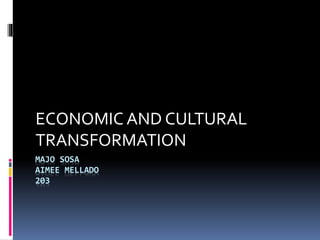INDUSTRIALIZATION MAJO SOSA ,AIMEE MELLADO 203
- 1. ECONOMIC AND CULTURAL TRANSFORMATION MAJO SOSA AIMEE MELLADO 203
- 2. INDUSTRIAL TRANSFORMATION ’é¦ Change all aspects of life. It started in London, in the middle of the 1750, started to spurred on inventions. It changed the way people worked, and all aspects of life. ’é¦ Industralization: accelerated rapply
- 3. INDUSTRALIZATION ’é¦ Is the period of social and economic change that transforms a human group from an agrarian society into an industrial one ’é¦ It is a part of a wider modernisation process, where social change and economicdevelopment are closely related with technological innovation, particularly with the development of large-scale energy andmetallurgy production.
- 4. TRANSFORMATION OF CULTURE ’é¦ Transformation of culture, or cultural change, to the dynamic process whereby the living cultures of the world are changing and adapting to external or internal forces. This process is occurring withinWestern culture as well as non-Western and indigenous cultures and cultures of the world. Forces which contribute to the cultural change described in this article include: colonization, globalization, advances in communication, transport and infrastructure i mprovements, and military expansion.
- 5. ECONOMIC ’é¦ The factory system changed the way people lived and worked, itroduccing a variety of problems.
- 6. ECONOMIC AND CULTURAL TRANSFORMATIONS ’é¦ is the branch of economics that studies the relation of culture to economic outcomes. Here, 'culture' is defined by shared beliefs and preferences of respective groups. Programmatic issues include whether and how much culture matters as to economic outcomes and what its relation is to institutions.
- 7. SOCIAL AND ECONOMIC ’é¦ Social and economic systems throughout the world are becoming more complex and interdependent, and globalization is moving beyond the sphere of economics to engulf other aspects of life, particularly culture and security. Our current theories, strategies, and road maps are fast becoming out-dated and no new ones have emerged to take their place.
- 8. TRANSFORMATION OF CULTURAL ’é¦ The culture of your organisation is a reflection of the values and beliefs of the current leaders of your organisation, and the values and beliefs of past leaders that have been institutionalised in the incentives, policies, structures, systems, processes and procedures implemented during previous times. ’é¦ The culture of an organisation can best be defined as ŌĆ£the way things are done around here.ŌĆØ In order to change ŌĆ£the way things are done around here,ŌĆØ you not only have to change the behaviours of the current leaders and managers, you also have to change the institutionalised legacy of the past leaders.
- 10. ’é¦ The Industrial Revolution marks a major turning point in human history; almost every aspect of daily life was eventually influenced in some way. Most notably, average income and population began to exhibit unprecedented sustained growth. In the two centuries following 1800, the world's average per capita income increased over 10-fold, while the world's population increased over 6-fold.
- 11. ’é¦ In the words of Nobel Prize winning Robert E. Lucas, Jr., "For the first time in history, the living standards of the masses of ordinary people have begun to undergo sustained growth. ... Nothing remotely like this economic behavior has happened before. ’é¦ Starting in the later part of the 18th century, there began a transition in parts of Great Britain's previously manual labour and draft-animalŌĆō based economy towards machine-based manufacturing. It started with the mechanisation of the textile industries, the development of iron-making techniques and the increased use of refined coal.
- 12. ’é¦ Trade expansion was enabled by the introduction of canals, improved roads and railways.














